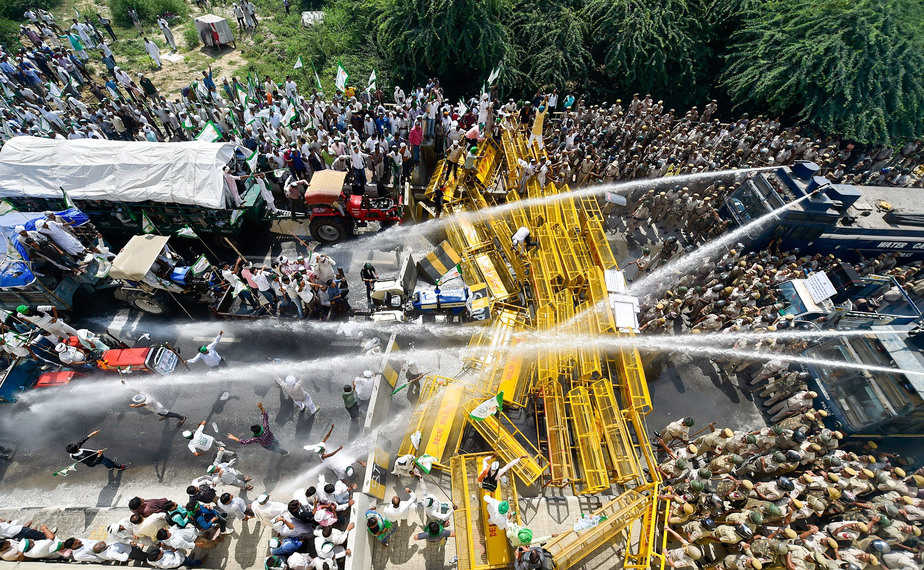Protesting farmers were not allowed to enter the capital this week. Whether this should be seen as a denial of their right to protest or an essential safeguard for the general public, remains debatable
On the birth anniversary of Mahatma Gandhi, a leader who believed that protests based on the principle of non-violence can overthrow the British, hundreds of farmers under the banner of the Bhartiya Kisan Union tried to enter the capital. In order to stop them, they were lathi-charged and tear-gassed.
The Constitution gives us the right to express our anguish, but should there be a defined and controlled way of doing it? Should authorities allow people to enter Delhi during protests? Can the possibility of such protests resulting in massive traffic jams and turning violent — causing immense inconvenience to Delhiites — suffice as a reason to restrict their movement? Then one can also raise the case of kawariyas as their journey too can pose a traffic nuisance. Should that too be stopped in the capital?
Delhi being the centre of power has witnessed innumerable protests, which have often put the authorities in a dilemma: whether to uphold their right to protest and allow the protestors to enter the capital or to restrict them citing security concerns. Around 24 years ago, hundreds of people from Uttarakhand (then Uttaranchal) marched to Delhi demanding statehood. When they were stopped at the border of Muzaffarnagar, violence erupted that killed several people. Many women were also allegedly raped and molested.
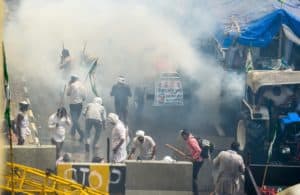
Such incidents have marred the nature of protests, giving it a negative connotation that arouses fear in the general public. Police see it as an imminent threat to safety that needs to be averted. Not to deny the fact that the right to protest is our fundamental right, but to what extent can we exercise a right that might come in conflict with people’s right to live safely and peacefully. Even as the right to protest is crucial for the healthy functioning of democracy, it comes with certain limitations, which if not taken into consideration can lead to the protest taking a violent turn.
In March this year, protesting farmers from Maharashtra reached Mumbai early in the morning to avoid causing inconvenience to commuters, especially students who were going to take their board exams. This gesture won people’s hearts. On the other hand, during the 2016 Jat protests demanding reservations, nearly 30 people died, women were allegedly raped and private hospitals were vandalised. There have been other cases where protests have been carried out peacefully, but there have been instances where the frenzied crowd has disrupted the routine life. However, can a few infamous examples be allowed to shape the narrative? How else can the marginalised make their voices heard, if not through such protests. To handle the situation without compromising on the democratic ideals, a middle path can be charted where the right to live peacefully and the right to protest can strike a balance.
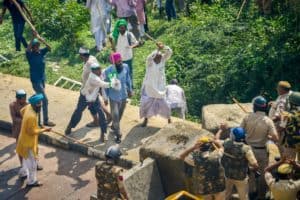
The farmers who tried to enter Delhi this week had some legitimate and basic demands — bring petrol and diesel under GST and payment of their pending amount with interest for sugarcane cultivation. The intelligence apprehended that they might become a nuisance and turn violent if they are allowed to enter Delhi, which is why they were halted outside Delhi. Their voice was heard though, as the TV telecast showed them live on Gandhi Jayanti, when their tractors tried to roll down police barricades. The police retaliated by unleashing water cannon and bursting teargas shells.
They had marched in large numbers to raise the issue of the agrarian distress that the farming community is facing across the nation. The farmers were participating in the Kisan Kranti Padyatra that had started in Haridwar on September 23 and were supposed to march to Delhi. On reaching the Delhi border in Ghazipur, Delhi police personnel and several battalions of the Rapid Action Force (RAF) erected barricades and the farmers were stopped from entering the capital.
Even force was employed to disperse the farmers; water cannons, tear gas and rubber bullets were fired at them. The UP Gate at Ghazipur was turned into a battleground. And yet, hours after the crackdown, farmers were patiently waiting to be allowed inside Delhi. After the farmers’ leaders had a closed-door meeting with the unspecified emissary of the establishment to defuse the crisis, the protest was called off.
The simmering anger against the establishment was palpable amongst the farmers gathered. The establishment was scared of the outcome. In 1988, BKU under the leadership of Mahendra Tikait, lead lakhs of farmers into Delhi and took siege of the Boat Club. This agitation shook the Rajiv Gandhi government. Thirty years later, Tikait’s son Naresh Tikait tried to enact the same act, but was thwarted with a heavy hand.
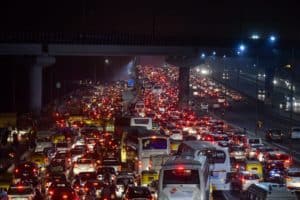
Uday Raj, 73, owns 20 Bighas of land, had participated in at least three such movements, including the 1998 historic siege in Delhi. “We don’t care about who is in power. The farmers will continue the fight for their survival and the movement,” he says. Raj points out that the prices of materials for farming—fertilisers, DAP, diesel—are skyrocketing while the rates of harvest are declining with time.
Agriculture is no more a lucrative proposition. Munfat Ali, 60, owns 40 Bighas land, concurs, “I had to take loan for farming and I am still waiting for the payments of sugarcane (minimum support price of the harvest acquired by the mills).” He argues, “While the loans of those defaulting have been waived off, farmers like us are still waiting for waivers.”
The chief minister of Delhi, Arvind Kejriwal came out in support of the farmers, “Why are the farmers being stopped from entering Delhi? It is wrong. Delhi belongs to all. They should be given entry in Delhi. We support their demands,” he told reporters at an event in Delhi assembly to mark Gandhi Jayanti. Rest of the opposition condemned the police action against the farmers in a chorus.
Many politicians were busy deriving political mileage out of it. But none of them suggested how we can allow such protests to happen in Delhi, while ensuring that they do not become a nuisance for the people, how their right can be exercised without putting the safety of people at stake.
An interesting example here is of Kanwar Yatra, which the Delhi establishment plans and executes in an organised manner every year. The same Delhi police which fired rubber bullets at the farmers, makes special arrangement to allow Kanwariyas to pass during their annual pilgrimage by diverting/ regulating traffic.
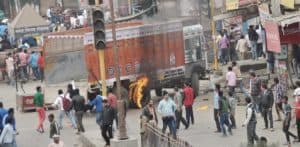
Delhi Traffic Police takes great care of that, for instance, no heavy commercial vehicles, except city buses, are allowed on the G.T. Road towards Shahdara and Wazirabad Road to Ghaziabad and Meerut up to Hardwar. The police never resort to using force despite several incidents of violence, and vandalism by mobs of Kanwariya.
By stopping the farmers, the establishment may believe that it managed to prevent something that might have come close to the 1998 siege. The politicians forget that they themselves don’t miss a chance to protest on grounds of injustice. Way back in 2005, former PM Atal Bihari Vajpayee and the then NJP president Lal Krishna Advani threatened to stall Parliament proceedings to protest against the unceremonious dismissal of the Manohar Parrikar government of Goa.
Then in August 2012, to protest against the proposed allowing FDI in retail, BJP leaders Nitin Gadkari — the then BJP president, Advani, Sushma Swaraj, Rajnath Singh, Murli Manohar Joshi amongst others lead a protest of some 10,000 traders from different parts of the country in Jantar Mantar. They were also protesting against the Food Security Bill and the Goods and Services Tax (GST) which they accused is being introduced “under foreign pressure.”
It is true that at any cost, law and order has to be maintained. But was the whole security apparatus of the capital threatened by the agitated farmers or was it just an easy way to control dissent before it went out of bounds?. Delhi police plays victim rather than an aggressor, as seven policemen, including an assistant commissioner of police, were injured. They justify what they call as the “minimum use of force” — 20 tear gas shells and water cannons — in a statement: “Despite persuasive methods requesting them to wait till outcome of talks of their leaders with the government, a section of crowd turned violent and tried to break barricades forcefully through tractor-trolleys and were also carrying lathis.”
But insiders in the Delhi Police say that there were clear instructions not to allow the agitating farmers in the city to disrupt the city life and Gandhi Jayanti celebrations. “We are capable of dealing with all eventualities. Ultimately, it’s a political decision,” asserts a former commissioner of Delhi Police who doesn’t want to be named, adding, “The agitation was defused at the border, the same could have been done inside the city. It has been done several times in the past.”

